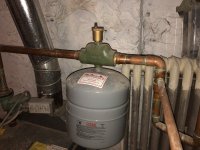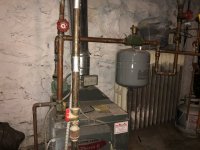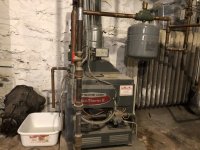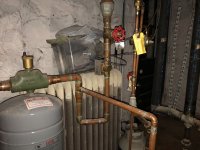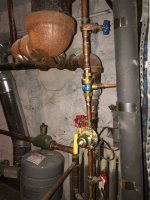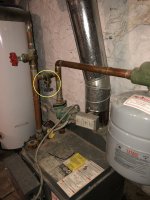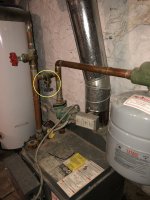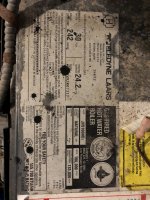That type of expansion tank has an internal diaphragm separating the water connection end from the air-valve connection end:
To operate correctly the initial air charge before the system is pressurized has to be pumped up to the target system pressure + 1 to 3 psi. If the initial air pressure is too low there isn't enough volume for the water to expand into as the water in the system expands due to heating up.
Assuming the expansion tank is properly sized for the system's water volume & temperature swing (not always a good assumption, the system pressure as measured at the boiler needs to be 3 psi + 0.433 x the vertical distance in feet between the pressure gauge and the top of the tallest radiator and the top floor. The expansion tank is usually 2-3' (sometimes more) above the boiler's pressure gauge, which adds 1-2 psi to the expansion tank's pressure requirement, and adding 1-2 psi to that ensures that the majority of the tank volume becomes useful expansion volume.
So let's say the boiler's pressure gauge is 7' below the first floor, and you have 2 more floors above that at 10' per, and a 3' tall radiator above that, adding up to 30'. So the minimum pressure (measured at the boiler) required to push water to the top radiator is 0.433 x ( 7' + 10' + 10' + 3')= 13 psi. There needs to be another ~3 psi to overcome the pressure differences induced by pumping, so the boiler needs to be set to 13 psi + 3 psi = 16 psi, not less, but also not much more.
Let's assume the midpoint on the tank is 4' above the pressure gauge on the boiler, which adds 4' x 0.433= nearly 2 psi to the minimum tank pressure, but add another 1 psi for good measure for 3 psi to ensure maximal useful volume, but not much more, or it's shock-absorber effect is diminished. That means the pre-charge on the tank for maximal useful expansion space is 16 psi + 3 psi = 19psi (for a system that's charged to 16psi at the boiler.)
While it's easier to get the pre-charge correct when the tank is disconnected from the system, with zero back pressure on the water side, since you have no isolating valve between the tank & air scoop you can do it iteratively. Start by calculating the system's target pressure + tank pressures. With the system at idle (warm but not maximum temp boiler, no pumping) if the system pressure is reading higher than the target pressure, drain water out of the system (there is usually a drain port at the boiler, if not, carefully use the pressure relief valve), until the system is at the target pressure.
Then, pump air into the tank's schraeder valve up to the calculated tank pressure.
Check the system pressure again- if there was a lot of water in the expansion tank the pressure may have bumped up. Drain more water as necessary to hit the target pressure, then check the pressure at the tank, pump in more air, as necessary.
Repeat.
In a very few cycles pumping air into the tank has little or no effect on the system pressure, which is where it want's to be.
Many systems will have a pressure reducing "auto-fill" valve to automatically add water to the system when the system pressure drops below the pre-set on the auto-fill. If that valve is set improperly or it's valve seats are worn allowing excess water into the system the system pressure can rise over time. There is usually an isolating valve between the auto-fill and the potable supply. Once the system is set to the proper pressure, it's usually a good idea to close the isolating valve to prevent seepage. If the system's pressure drops over several days/weeks it's an indication that it's losing water somewhere, which is something to be investigated. You can cross ( or burn

) that bridge if & when you come to it.
If the diaphragm in the tank is leaking the tank will become water logged. The tank will "thud" rather than ring when tapped on the air-end of the tank, and water will come out when the center pin on the air valve is pressed. The only solution there is to replace the tank (properly pre-charging it before installing onto the plumbing, of course.)

